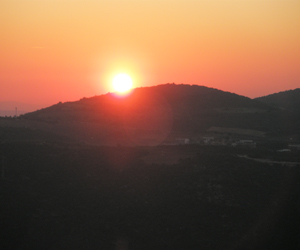Hula Nature Reserve
The Hula Reserve
A short drive north from Tzfat lies the Hula Nature reserve. This area was, at one time, an expanse of fifteen thousand acres, and was a resting place for migrating birds who, twice a year, flew over the area on their way from North Europe to Africa and then back again.
In the 1950s, the new Israeli government decided to drain the marshes of the Hula lake to create farming land. Due to the ecological ramifications of draining the swamp, the authorities, in 1994, decided to restore part of the marsh by reflooding a portion of the reserve.
In the intervening years, many of the birds who had once made their homes in the Hula moved on, but after the reserve was restored, a number of species returned, some nesting there permanently. Cranes, black and common storks, pelicans, pygmy cormorants, geese, ducks and several types of herons can now be seen in the reserve throughout the year. During migrating season, bird-watchers have counted 390 species of birds that come to the reserve to rest, and some species, like the white-tailed eagle, are being reintroduced to the area by the staff of the reserve. Professionals have also noticed some rare birds, including the Ruddy Shelduck, Red-crested Pochard and White-headed Duck.
The Oforia
Visitors enter the reserve through a Visitors Center, called the "Oforia" (bird house). Here, they experience a multi-sensory simulation program. They can wander through the displays to learn about the Hula Nature Reserve and its history - the plants and animals that once existed in the reserve, and those which have been reintroduced to the area. In the screening room, a combination of 3-D light effects, sounds, smells and movements give the viewer the feeling of flying among a flock of birds as though one is a bird - feeling the winds and weather, the air turbulences, helping the visitor better understand the migration of the birds.
Visitors exit the Visitors Center and begin their walk to the reserve. Bikes and small jeeps are available for rentals. For walkers, the stroll into the reserve takes about 15 minutes, during which time the birds circle overhead. As one walks, one can see various animals, reptiles (mostly different species of turtles) and fish. There are many spots to sit and relax while watching the birds flying overhead, but at the end of the trail, a lookout is perched on a hill near the birds' nesting area so that visitors can observe the birds without scaring them.
The greatest number of species can be viewed during the winter, from October through May, which includes both the fall and spring migrations. The best time of day to come is the late afternoon, immediately before sunset, when the birds, who leave the reserve during the day, fly in for the night. As one gazes upward, one can see thousands of birds of every imaginable size and species gathering in the Reserve. It's a sight that is not soon forgotten.
Hula Valley Birds Festival
There is a Hula Valley Birds Festival for one week every November. Birders from all over the world come to view some of the 500 million birds that fly over Israel every autumn, making this country a paradise for nature lovers and twitchers. Enjoy guided tours with professionals, lectures, ringing demonstrations and a mobile hide.

